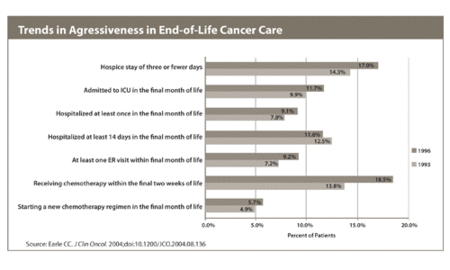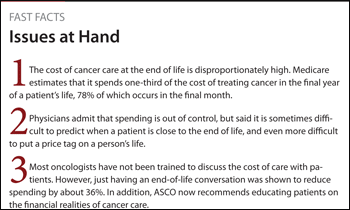Experts debate if the cost of end-of-life cancer care is too high
A majority of the cost of cancer care is at the end of life, and currently there is little incentive for a change in that equation.
According to a national survey of patients with cancer and their families, 25% exhausted or nearly exhausted their savings in treating the disease.
Even among families with health insurance, 33% of respondents to the survey conducted by the Kaiser Family Foundation and the Harvard School of Public Health said they struggled to pay medical bills. Among those who had ever been uninsured, 27% delayed or skipped treatment because of financial concerns.
The NIH has estimated that Americans spent $89 billion on direct costs for cancer care in 2007, with that expense expected to increase as the baby boom generation ages.
The cost of cancer care is even higher in the last weeks of life. Medicare spends one-third of the cost of treating cancer in the final year, and 78% of that spending occurs in the final month.
|
Photo by Bruce Wahl, Beth Israel Deaconess Medical Center |
The experts interviewed for this story about the cost of cancer care at the end of life were unanimous in saying the expense is untenable. In a two-part series, HemOnc Today will explore why costs are so high and the difficulties involved in bringing them down.
Part one looks at the difficulty of predicting death, the importance of the end-of-life discussion and the need for comparative effectiveness research. Part two, which will be published in our Oct. 10 issue, will look at the possibility of rationing health care, including the state of Oregon’s experience with drafting and implementing a health care plan that includes rationing.
Although there are some clues, especially functional status, physicians do not really have a good idea about exactly when a patient is likely to die, said Vivian E. von Gruenigen, MD, associate professor in the division of gynecologic oncology at University Hospitals MacDonald Women’s Hospital in Cleveland. Von Gruenigen has studied terminally ill patients to determine the optimal time to switch treatment from curative to palliative. She said that more research dollars and attention should be focused on developing predictors of the end of life.
“As a physician caring for women with ovarian cancer, endometrial cancer and cervical cancer, when it comes to the point in their journey when they’re toward the end of life, they all die differently,” she said. “There should be certain predictors that are developed through prospective research that would help physicians qualify and quantify when their patients are near the end of life.”
Aggressive treatment at the end of life is expensive and it is becoming more common. In results published in 2004, Earle et al found that in 1996, 5.7% of patients in the study started a new chemotherapy regimen within 30 days of death compared with 4.9% in 1993 (see chart).
From 1993 to 1996, they found that the average number of days from the start of a new course of chemotherapy to death decreased (140.5 days vs. 127.7 days) and that the percentage of patients still getting chemotherapy in the last two weeks of life increased (13.8% vs. 18.5%).
Joseph W. Shega, MD, assistant professor in the division of hematology/oncology at Northwestern University’s Feinburg School of Medicine, said the number of things done to patients — such as treatment in the intensive care unit and the use of ventilators — makes end-of-life care more expensive.
“As patients get sicker and we maintain our curative intent, we tend to do more and more high-tech and expensive things,” he said. “That drives most of the cost.”
Aggressively attacking a patient’s disease near the end of life usually does not work and often lowers the patient’s quality of life. Results of a study published in Archives of Internal Medicine in March showed that higher medical costs in the final week of life were associated with more physical distress and worse overall quality of life. Moreover, in the study, Zhang et al found no survival benefit associated with the higher spending.
Results of a study published in 2008 by Alexi A. Wright, MD, and colleagues showed that, even after correcting for severity of illness, patients who did not receive aggressive care in their final weeks had a mean quality of life score of 6.4 out of 10 compared with 4.6 for those who received at least three aggressive therapies.
Holly G. Prigerson, PhD, director of the Center for Psycho-oncology and Palliative Care Research at Dana-Farber Cancer Institute and senior author on both studies, said that overly aggressive care at the end of life amounts to little more than “buying misery.”
“In the Wright paper, we found there was a dose response: The more aggressive procedures received at the end of life, the worse your quality of life,” she told HemOnc Today. “The longer you’re in hospice, the better your quality of life. End-of-life care costs appear to be purchasing misery rather than buying better care.”
The flip side of the argument is that, sometimes, aggressive treatment works.
“Obviously, there are specific circumstances where even late in a disease, a novel treatment might have a very unexpected, terrific result,” said Lowell E. Schnipper, MD, chief of hematology/oncology at Beth Israel Deaconess Medical Center and chair of the ASCO Cost of Care Task Force. “That was the case with imatinib (Gleevec, Novartis). In very advanced cases of sarcoma or leukemia, imatinib helped.”
Putting a price on life
Douglas Yee, MD, director of the Masonic Cancer Center, University of Minnesota and a member of the HemOnc Today Editorial Board, discussed a patient with terminal breast cancer he treated recently. A mother with three young children, she had undergone several rounds of chemotherapy and presented at the hospital with increasing shortness of breath. By any measure, she was a good candidate for hospice, Yee said.
|
|
“The ICU team looked at me like I was nuts for continuing to give chemotherapy after 10 regimens,” he said.
But after going on a ventilator and getting treatment for lymphangitic disease due to her breast cancer, she eventually left the hospital and lived for another year.
“Even though physically she wasn’t asymptomatic that year, that was a very meaningful year for her and her family,” Yee said. “If we had made an economic decision a year ago that we had to stop treating her and let her succumb to her disease . . . It really is an impossible call to make for both the patient and the physician.
“I would venture to say the last year or six months of her life were pretty expensive, but if we try to make hard and fast rules of when you can and can’t do anything, it’s going to be very difficult to define the value of life,” Yee said.
“Can we do the calculation like they do in the United Kingdom, when you have to have X number of dollars for six months of life saved for a particular drug? That’s a hard thing to communicate to patients; that a regulatory agency doesn’t think we can afford to take a chance at extending your life.”
Von Gruenigen argued that these kinds of stories highlight the need for more research into finding ways to predict death more accurately. She noted that the National Cancer Institute website has extensive information on treating cancer, but says little about treating dying patients.
“There is nothing. It stops at salvage,” she said. “There’s all this research at diagnosis — how to operate, what type of chemotherapy to give, the different options for drugs at recurrence — but there is nothing on those schemas after that; there should be information to guide physicians on when to stop therapy.”
An uncomfortable conversation
For most patients, research shows that end-of-life discussions both improve quality of life and reduce costs. In the Zhang study, the researchers found that costs were 35.7% lower (in 2008 dollars) for patients who had end-of-life discussions compared with those who had not. Prigerson said the cost savings could be even higher.
“[That study is] a very conservative estimate of the difference in cost savings that are likely to occur,” she said. “We didn’t include opportunity costs, such as the cost for a family member to miss work to perform home care. We didn’t factor in costs for visiting nurses, equipment or drugs. This is just a very gross estimate of being on a ventilator, being resuscitated, being in the ICU, going to hospice vs. being at home without hospice, etc.”

The problem is that most patients are not having these conversations: Only 31.2% in the Zhang study. For the most part, said the experts who spoke to HemOnc Today, oncologists are not trained to tell patients that further treatment is likely to be futile, are not comfortable having that conversation and have few incentives to do so.
“Oncologists weren’t trained to have those end-of-life discussions,” Prigerson said. “They didn’t go into oncology to tell people there is nothing more they can do to cure their cancer.”
Schnipper agreed: “There is some very, very fundamental lack in generating these discussions on the part of physicians. Whether the primary issue relates to physicians being trained into being active interventionists and pushing the frontiers of disease back, we’re not sure what the problem is, but clearly it’s a problem.
“It’s not that you abandon care; it’s that you switch care from anticancer treatments to support treatments. By doing that, fewer people with terminal cancer will be in ICU, fewer people will get inappropriate treatments that are toxic and expensive. But we really have a challenge ahead of us to make it happen,” he said.
Hospice use, which saves money, does not happen as often or as early as it should because physicians are not having these end-of-life discussions.
“Hospice use in cancer patients has gone up substantially, but the issue is that it’s only in the last three days of life that patients get enrolled,” Shega said. “The referrals are so late that patients and families can’t benefit from hospice as they should. The conversation is usually framed as ‘What else can we do?’ and that may lead to discussions about another line of chemotherapy or more chemotherapy, instead of talking about what the goals should be based on how the patient feels.”
The other problem, Yee said, is that neither physicians nor administrators have a financial incentive to stop treating disease. The current fee-for-service payment model pays for treatment, not what are likely to be multiple long and complicated conversations.
“If anything, physicians are encouraged to give more therapy because with our fee-for-service reimbursement pattern, we have no disincentive to stop chemotherapy,” Yee said. “In most hospital systems, revenues from chemotherapy are a substantial part of the hospital’s financial well-being. If I were a hospital administrator, I’d be even more in favor of giving expensive therapy because, and this sounds very cynical, it’s healthy for our hospital system. It’s not healthy for our country, but it’s healthy for our system.”
What would save money, according to Yee, is better comparative effectiveness research. The Obama administration has set aside $1.1 billion to examine not only the clinical efficacy of a given treatment but also whether one treatment is actually superior or more cost- effective than another.
As it stands now, physicians use drugs with no idea if they are working, Yee said.
“If I had to say what health care reform could be done to help us save money … we should encourage people to enroll in clinical trials to answer some of these questions regarding predictive factors to identify benefit from individual therapies,” he said. “The number of people that go into clinical trials in the United States is vanishingly small.”
ASCO’s position
ASCO released a guidance statement on the overall expense of treating cancer in June. In it, ASCO encouraged oncologists to discuss the potential cost of care with patients. Schnipper said that does not mean physicians should necessarily discuss the price tag on each treatment, but they should strive to educate patients about the financial realities of fighting cancer.
“By ASCO making this suggestion that cost be included in discussions between patients and doctors, we’re not suggesting that oncologists speak about medical-social policy,” Schnipper said. “The issue is that the rising cost of novel drugs places a huge burden on the patient. In many instances, the fractional benefit over less expensive standard treatment is so small that it is important that the patients have an understanding of the potential difference between two treatments and the potential impact those differences are likely to have on their family’s finances.”
The committee also reached a conclusion similar to Yee’s, and said “the current health care system in the United States does not promote use of the most cost-effective medical care.”

“It’s fair to say that we’re operating in a nonintegrated health care system in which the incentives are aligned with doing more in terms of interventions and not necessarily providing impetus for the kind of cognitive discussions that are the essence of being a good physician,” Schnipper said.
An end-of-life discussion, however, is the wrong time to bring up cost for the first time, he said.
“There is a substantial risk for misinterpreting the interests and the goals of the care team. There is always the fear that somebody could misinterpret a discussion, raising the issue as, ‘They’re trying to save money rather than save Dad,’” he said.
“What oncologists at that juncture need to do most is not so much talk about cost directly but talk about what’s right for the patient and the family. What’s right for somebody who’s likely beyond the positive benefits of the treatment is to spare that patient the toxic effects of treatment that just make the quality of one’s life even worse, and care for them in ways that help treat the things that are much more effectively treatable like pain, infection or difficulty breathing,” Schnipper said.
Rationing care
The most obvious way to lower costs is to ration care — those who can afford expensive treatment get it and those who cannot get something else. It is also the least likely to be implemented in a wide-scale manner. Even if comparative effectiveness research can show that an expensive course of treatment does not help a particular population, the idea of denying health care for financial reasons is anathema to most Americans, some experts contend.
“Patients and doctors in the United States are so proud of trying new and novel treatments offering hope, I have trouble envisioning a system that would deny that,” Prigerson said.
Yee added, “Our country has decided, and rightly so, that one’s income level should not dictate the level of care one gets.”
But the state of Oregon has implemented a plan to ration care to those with Medicare coverage. The health care systems in Canada and the United Kingdom, populations with admittedly different expectations about health care and ideas about the role of government in society compared with the United States, also ration care. In part two of this article, HemOnc Today will look at how those systems work. – by Jason Harris
![]()
Should oncologists discuss the cost of treatment with patients?
For more information:
- Earle CC. J Clin Oncol. 2004;doi:10.1200/JCO.2004.08.136.
- Huskamp HA. Arch Intern Med. 2009;169:954-962.
- Keating NL. J Clin Oncol. 2006;doi:10.1093/jnci/djj298.
- Kim P. J Clin Oncol. 2007;doi:10.1200/JCO.2006.07.911.
- Matsuyama R. J Clin Oncol. 2006;doi:10.1200/JCO.2006.03.6236.
- Meropol NJ. J Clin Oncol. 2009;doi:10.1200/JCO.2009.23.1183.
- Naik AD. N Engl J Med. 2009:360:1929-1931.
- Wright AA. JAMA. 2008;doi:10.1001/jama.300.14.1665.
- Zhang B. Arch Intern Med. 2009;169:480-488.


